Scappo
My recommendation is that, when visiting a new place, read what you can about it. If you have a guidebook, especially read the highlighted sections. The ones the author has gone to the trouble of putting in a box. They might have helpful information. For example: Rick Steves’ chapter on Venice has a section on “Floods.â€Â Most likely every guidebook has a section on Venetian floods. There’s a reason for that.
Walking through Venice the night before I left, in the rain and wind, I saw a couple of warning signs that the water was coming. I did not, however, realize what the platforms that were set up running through the middle of the streets and piazzas were. I thought they were vendor tables for a street fair or something. If I’d read the section on floods, I would have known that they were elevated walkways, placed out by the city the night before an imminent flood. As it was, I went to bed blissfully unaware of what I would find the next morning.
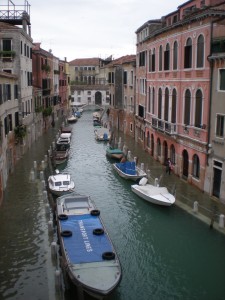
When I opened the shutters the morning of my departure, I smiled at the quiet day. The night had been rough. It was really windy. So much so that I had to close and secure the shutters that had been banging on the stone walls. I pulled out my camera to take a last pic of the view from my window. And then I realized that something was different. The sidewalks were part of the canal.
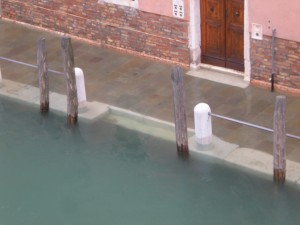
Where was that damn guidebook…
Evidently, this is rather common for Venice. Not surprising, now that I considered it. However, there was nothing in the guidebook about how to get yourself from your hotel to the train station. So, I consulted my wardrobe, chose thermal underwear and quick-dry travel pants for the journey and rolled them up to my knees. Wondering if the Montin had a flood-blocking door plate, I headed downstairs for some breakfast and to check out the scene.
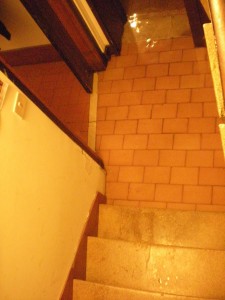
Yes, that’s water at the bottom of the stairs. The dining room was totally flooded. In fact, the front door stood open, and several people were sitting at partially submerged tables. They were all wearing high rubber boots. (The guidebook said nothing about boots.) I stepped into the water and watched the eyes of the locals widen. “Coragea.â€Â No, I wasn’t brave, just hungry, and wondering what else I was supposed to do. The frigid sea water rushed into my waterproof shoes and up over my ankles. I walked to the front door and looked out.
“Just wait. This will be gone in about 5 minutes.â€Â “Really?â€Â This guy was a local, but I couldn’t see how this was going to clear that quickly. “Maybe 10.â€
There was no breakfast this morning, and I was beginning to think it might take a little while to get to the station. I turned to the man behind the desk and asked if the trains would be running alright. He assured me they would, but warned that the boats might not, because the height of the water made it such that they could run aground – and into houses. Okay, well that ruled out a vaporetto ride. I’d be walking it. I sloshed back upstairs (waterproof shoes work both ways. Water can’t get out so much, and I’m pretty sure the “ventilation system†wasn’t designed for Venetian floods) to pack and get underway.
When I hit the streets, it was clear it would take longer to walk across town this time. The water was deeper on the street than in the hotel. The locals were walking slowly, making sure the water didn’t splash up over the tops of their knee-high boots. I had no such concerns.
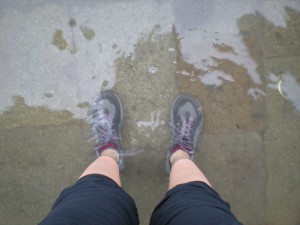
I trudged along, smiling at the folks in the streets as I went. As if Venice needed anything else to make it seem any more strange. The streets had become canals. I was no longer able to tell which was which.
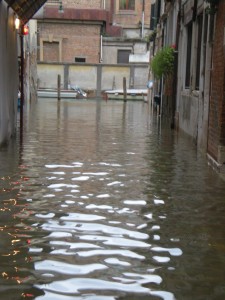
The water seemed to be getting deeper. People were walking seriously slowly now as the water was about an inch below the top of their boots. Men in hip waders were starting to appear.
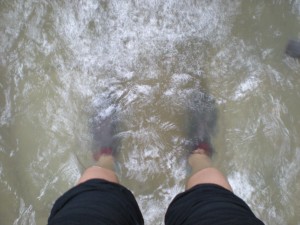
After about 20 or 30 minutes of walking in really cold water, I came across a little bridge to a point where I could actually see the ground. I think I thanked the saints a little. It didn’t last long though. A couple of blocks later I was back to mid-calf water. It seems that Dorsoduro is one of the lowest parts of the city.
When I crossed a big bridge from the neighborhood, I hit dry ground. And found lots of people wearing ridiculous fluorescent plastic boots.
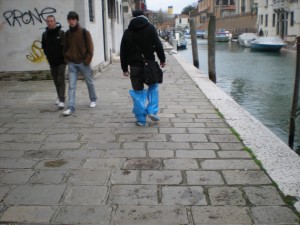
For some reason, these were being sold in the one area of town that was dry. And that’s where people were wearing them. Insanity. I really could have used some of those boots about an hour earlier. It was alright, though. The water in my shoes had finally warmed to the temperature of my feet, and I was having a grand adventure. I found one of the very few shops that was open (I’d had to abandon my hopes of shopping on the way to the station), bought some breakfast, took a last look at the city as I walked the span of the newest bridge over the Grand Canal (that I had read about in the guidebook) and found a place to empty my shoes.
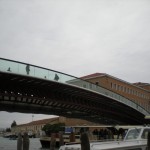
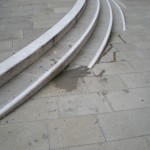
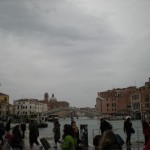
I’d made it out. No boots. Just me and my awesome shoes. Which now smelled like the Mediterranean Sea. Only 6 more hours on the train. I smiled as I took my seat and pulled out dry socks.


